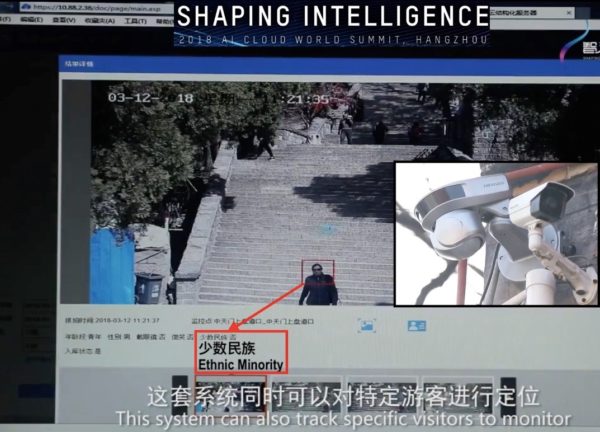- The arrest this month of Meng Wanzhou, chief financial officer (and daughter of the founder) of Chinese tech firm Huawei, over potential violations of US sanctions on Iran brings to a head growing scrutiny of Chinese CCTV giant Hangzhou Hikvision Digital Technology. Known simply as Hikvision, the company is already subject to bans by the US and Australian governments.
- Hikvision came under fire for providing equipment for massive prison camps in Xinjiang, where as many as two million Uyghurs are interned. Its connection with Tibet is less well-known, but the company—one of the world’s largest makers of security cameras and other spying equipment—trialed its surveilance technologies in Tibet as part of an unprecedented system of oppression and control.
In August 2018, US President Donald Trump signed a law that forbade US government agencies from buying surveillance products from Chinese firms including Hikvision, ZTE Corp. and Huawei Technologies Co. A month later, it was reported that the US was considering sanctions against companies and Chinese officials over Beijing’s mass detention of ethnic Uighurs and other Muslim minorities in concentration camps.
Hikvision, a company that is controlled by the Chinese government and has internet-enabled cameras installed in more than 100 countries, has installed surveillance systems in a re-education camp in Xinjiang (East Turkestan) and mosques and has also been directly involved in a large-scale integrated surveillance program in the Xinjiang Uyghur Autonomous Region that is terrifying in its scope and scale.[1] The company also has offices in Lhasa and has provided surveillance tech for the Qinghai-Tibet railway.
Hikvision’s work in Tibet is particularly associated with the former Chinese Communist Party chief of the Tibet Autonomous Region, Chen Quanguo, who is now in charge in Xinjiang. In Tibet, Chen used surveillance tech supplied by Hikvision as part of the development of one of the most dystopian and intrusive police and security states in the world—a system of technological totalitarianism.
Chen developed the “iron grid” system that was first focused on profiling and targeting individuals regarded as potentially problematic to the state, such as Tibetans who had returned from India, those who had attended teachings by the Dalai Lama in exile and those who were former political prisoners. Today, the system has expanded in scope and potentially targets all Tibetans and all Uyghurs—entire “ethnic” populations—assisted by new technology using facial recognition supplied by Hikvision that can distinguish “ethnic minorities” from Han Chinese.

A video released by Hikvision showed an individual captured on camera identified as an “ethnic minority” and referred to a case study trial of Hikvision surveillance cameras at Wutai Shan, a sacred pilgrimage mountain for Buddhists that has strong religious associations for Tibetans.[2] IPVM, a video surveillance information source, reported in May that while Hikvision had not marketed this, it had been verified from information disclosed in the company’s “AI Cloud World Summit.”[3]
IPVM stated: “Minority/ethnicity analytics are certainly technically possible, though, of course, how accurate is one question. However, they are not widely promoted and, in the video surveillance space, Hikvision is the only manufacturer we have seen offering them.”
ICT has tracked advertisements for jobs for Hikvision in its Lhasa office, which include job postings calling for candidates with a background in security.
Hikvision appears to have been active in Tibet several years before Chen accelerated the implementation of total surveillance. The use of its systems for the Qinghai-Tibet railway from Golmud to Lhasa, which opened in 2006, is one of the success stories cited by the company. Its website states: “After a thorough investigation and research, China Railway Signal & Communication Corp. (CRSC) that is responsible for the security system integration of Qinghai-Tibet Railway, decided to use the products from Hikvision, the leading digital surveillance products supplier with the headquarters in China, to deliver a powerful surveillance system and guarantee the safety of the railway. There are in total 200 sets of HIKVISIONDS-8016-HC Network DVRs installed in the system.”[4]
Established in 2001, Hikvision, which originated as an official research institute, maintains strong ties with the Chinese government. More than 42 percent of the company is owned by China’s state-owned enterprises.
Hikvision, which supplies surveillance technology globally, is now under increasing scrutiny as its parent company, China Electronics Technology Group, was faced with a ban on importing critical US components under the Trump administration. Following an Australian TV investigation in September, Australia’s defense department pledged to remove identified Hikvision cameras across Australia’s military, citing national security concerns.
The US is now considering Magnitsky Act sanctions on Chinese officials and “entities assisting [Xinjiang] officials in mass detentions and surveillance of ethnic minorities” such as Hikvision and Dahua,[5] which have won over $1.2 billion in large-scale surveillance projects in Xinjiang, including in prison camps, since 2016. If passed, these sanctions would freeze all of Hikvision’s and Dahua’s US assets and ban US entities from doing business with them, effectively ending their US operations.[6]
A report by Bloomberg this month states that “Hikvision’s involvement in domestic surveillance, deals with Iran and dependence on US components make it a sitting duck,” adding that following the arrest of Huawei’s chief financial officer, “investors shouldn’t be surprised if Hikvision, whose largest shareholder is a state-owned company, goes next.”[7]
Footnotes:
[1]IPVM, ‘Evidence Of Hikvision’s Involvement With Xinjiang IJOP And Re-Education Camps’, October 2, 2018, https://ipvm.com/reports/hikvision-xinjiang
[2]Video from the AI Cloud Summit, http://aicloudsummit.hikvision.com/hikvision/video-content.html?id=51
[3]Held on March 30, 2018, in Hangzhou, where Hikvision is based: http://aicloudsummit.hikvision.com/hikvision/. ‘Hikvision’s Minority Analytics’ by John Honovich, IPVM, May 8, 2018, https://ipvm.com/reports/hikvision-minority
[4]‘Hikvision’s Network DVRs Secure Qinghai-Tibet Railway’, Hikvision company website, http://hikvision.am/en/success-stories/transportation/hikvisions-network-dvrs-secure-qinghai-tibet-railway.html
[5]‘U.S. Weighs Sanctions Against Chinese Officials Over Muslim Detention Camps’ by Ed Wong, September 10, 2018, https://www.nytimes.com/2018/09/10/world/asia/us-china-sanctions-muslim-camps.html
[6]‘Evidence Of Hikvision’s Involvement With Xinjiang IJOP And Re-Education Camps’, by Charles Rollet, IPVM, October 2, 2018, https://ipvm.com/reports/hikvision-xinjiang . Also see Human Rights Watch, ‘China: Big Data Fuels Crackdown in Minority Region: Predictive Policing Program flags individuals for investigations, detentions’ by Maya Wang, February 26, 2018, https://www.hrw.org/news/2018/02/26/china-big-data-fuels-crackdown-minority-region
[7]https://www.bloomberg.com/opinion/articles/2018-12-07/huawei-effect-threatens-china-s-spy-tech-champion